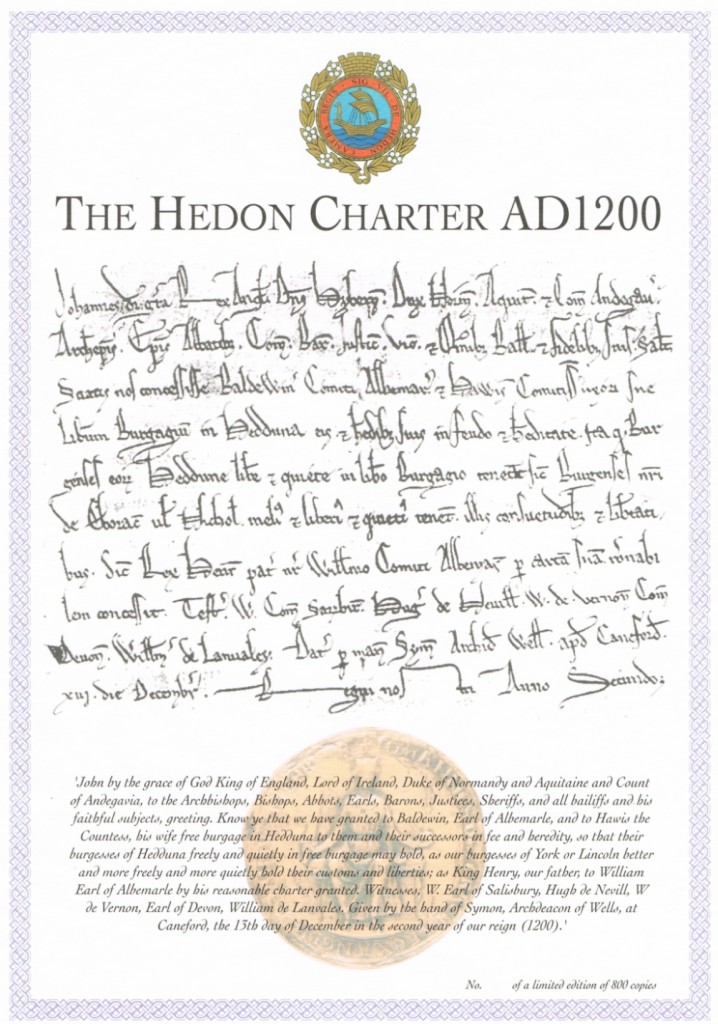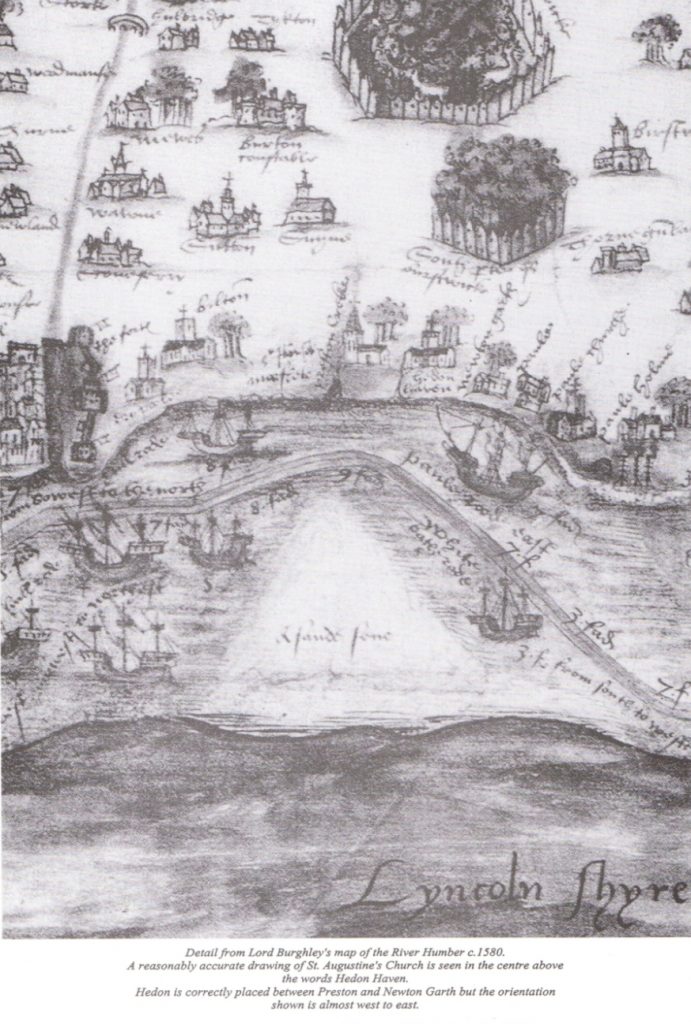The parish of Hedon is situated in what was once the wapentake of Holderness (middle division), part of the historical East Riding of Yorkshire (see maps in Introduction). It had no recorded sub-parishes before the 1832 parish boundary changes.
Local tradition asserts that the settlement that became Hedon was a place of some importance in Saxon times, but that it was destroyed by the Danes after a battle fought on a spot which has ever since been known as Danes’ field. However, a more likely claim is that it was the Norman, William le Gros, named after his great size but whose official titles were Count d’Aumale, Lord of Holderness and Earl of York, who founded Hedon. The name appears in 1115, when William’s father Stephen gave a hospice beside the Hedon river to the abbey of Aumale in Normandy, along with free passage across the Humber. Moreover, it has been suggested that the name Hedon was derived from Hedonisilva, the name of the church which was used by the canons before the abbey was built and was possibly situated in the area of Hadencourt or Hardonseille, both places lying a few kilometres south of Aumale.


Hedon was built out of lands taken from the parishes of Preston and Burstwick on the Hedon river (later known as Hedon Haven), giving access via a navigable channel to the Humber estuary both to the new town and to the count’s demesne lands around Burstwick. Hedon was long considered part of Burstwick manor and administered as part of the honor of Holderness, until a royal charter granted by Henry II in 1158 made the town a borough. However, its new status accorded the burgesses few liberties, as it would remain under the control of the Counts of Aumale until 1260, when the last one died, and later under the Lords of Holderness. King John confirmed the terms of the charter in 1200, and in 1280 the honor of Holderness passed to the Crown, when further liberties were considered but not enacted. It was only in 1348 that a detailed charter was granted by Edward III, stipulating a wide range of liberties and the governance of the town by a mayor, bailiffs and other officers. The first mayor took office in the same year. He and two bailiffs were responsible for law and order within the borough boundaries and for the collection of harbour duties, town rents and tolls. The mayor was protected by the sergeant-at-mace who carried his weapon to defend his master as he went about his duties. Hedon is the proud owner of the oldest civic mace in the country, which was acquired at the same time as another charter granted by Henry V in 1415, when the town was empowered to hold courts. Later, two maces of more elaborate design, dating from the reigns of Henry VI and Elizabeth I, were acquired. In 2009 I was accorded the immense privilege of a private viewing of the maces by the then mayor of Hedon, Mike Bryan.
 and local historian Martin Craven, 2009 |  photo Andy Beecroft |  and Hazel Pickering, 2009 |
Hedon had the rare distinction of coining money for King Stephen c1153, probably because William d’Aumale had consistently supported him throughout the civil war. In 1272, Henry III granted the Lord of Holderness a fair at Hedon, on a site north-east of the town that still bears the name Magdalen, to be held yearly on the eve, day and morrow of St. Augustine and for five days following. Three parish churches came to be built in the town, all of which indicates a considerable amount of prosperity. However, Edward I’s patronage of nearby Kingston upon Hull and unresolved problems concerning the silting up of Hedon Haven all contributed to the equally rapid decline in the fortunes of both the town and the port. An inquisition held as early as 1280 declared that the inhabitants were “few and poor with many wishing to remove from the town in which they are taxed every year”. Much later in 1540, the traveller John Leland was able to add the historic postscript: “Swarming and choking of the haven, and Fier defacing much of the Town hath been the Decay of it. Treuth is that when Hulle began to flourish, Heddon decaied”. The harbour became overgrown with flags and reeds, and in time completely silted up. In 1774 an Act of Parliament was obtained to restore and preserve the Haven; a new cut was made which approached within a ¼ mile of the town, but it did not achieve the success that was anticipated. The town continued, however, to serve as a local market centre and the Haven carried limited traffic well into the 20th century.
 |  |  |  |
In 1974, following the passing of the Local Government Act of 1972, the ancient town of Hedon lost its borough status and became a town council. The members of the last borough council fought hard to retain some privileges and were able to keep and use its civic regalia and retain the office of mayor, ownership of the town hall and the silver collection as well as control of other matters of importance to the town. Notable burgesses, office holders and land and property owners over the centuries include members of the Fauconberg, Hedon, Constable, Hildeyard, Sykes, Guy and Iveson families.
The church of St. Augustine, known as the Pride or the King of Holderness, was started in 1190. (The Queen of Holderness is St. Patrick’s church at Patrington.) It is a handsome cruciform structure, built at different periods, as shown by the variety of its architecture. The chancel, transepts and original crossing piers are all late 12th or early 13th century. The nave and four of the bays of the arcades are later 13th, while the westernmost bay and the west front are mid 14th century. In the 15th century the tower was added, the crossing piers enlarged and the east window inserted in the chancel. The 13th century tomb slab of black marble, the 14th century effigy and font and the carving of a bishop holding a model of the church count among the monuments of interest to the visitor. The church is dedicated to St. Augustine of Hippo, an early Christian theologian whose writings are considered very influential in the development of western Christianity and philosophy. He was bishop of Hippo Regius, located in the Roman province of Africa, known to the later French colonisers as Bône, now named Annaba, a town on the coast of Algeria near the Tunisian border. By happy accident the author of these lines spent 4½ years working for a company of consulting engineers in Annaba between 1977 and 1981.
 |  later Bône, now Annaba, Algeria |  model of St. Augustine's church |  |
Both Puckerings and Pickerings are represented in Hedon. Isabel Puckering of the Puckerings of Flamborough (3rd generation) married Ralph Wade, Hedon’s bailiff in 1577 and 1579, and their children were born in the town. Anthony Pickering of the Pickerings of Holderness (17th generation) married Elline, the daughter of Henry Mapleton, mayor of Hedon in 1587. Their two children died in infancy and their mother only survived their second child by a few days. Anthony remarried and had a further three daughters and a son John who had fifteen children. John’s surviving sons gave rise to the huge Holderness family and its offshoots, the Pickerings of Wawne, Lincolnshire, Sledmere, Preston, Kilnwick 2, Barmston, Skeckling cum Burstwick and Welwick.
Sources:
https://www.genuki.org.uk/big/eng/YKS/ERY/Hedon
https://en.wikipedia.org/wiki/Hedon
The Victoria History of the Counties of England, volume 5, pp. 168-186 (not online)
http://www.hedon.gov.uk/History_22453.aspx
Description Géographique et Histoire de la Haute Normandie, volume 1, p. 173: https://books.google.fr/books?id=S8lWAAAAMAAJ&pg
The History and Antiquities of the Seigniory of Holderness vol. 2, pp. 104-180: https://www.google.fr/books/edition/The_history_and_antiquities_of_the_seign/mwQVAAAAQAAJ
The itinerary of John Leland in or about the years 1535-1543: https://archive.org/details/itineraryofjohnl01lelauoft
The Lords of Holderness, 1086-1260 (not online)
http://en.wikipedia.org/wiki/Counts_and_Dukes_of_Aumale
http://en.wikipedia.org/wiki/William_le_Gros,_1st_Earl_of_Albemarle
http://en.wikipedia.org/wiki/Hippo_Regius
